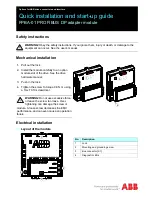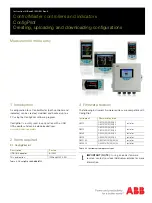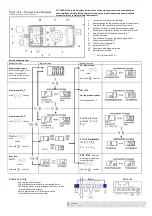
Main switch wireless control set
Model: RR868
[EN] V
2020
Manual Instruction
Importer:
SALUS Controls Plc
Units 8-10 Northfield Business Park
Forge Way, Parkgate, Rotherham
S60 1SD, United Kingdom
DISTRIBUTOR OF SALUS CONTROLS:
QL CONTROLS Sp. z o.o., Sp. k.
Rolna 4,
43-262 Kobielice,
Poland
www.salus-controls.eu
SALUS Controls is a member of the Computime Group.
Maintaining a policy of continuous product development SALUS Controls
plc reserve the right to change specification, design and materials
of products listed in this brochure without prior notice.
Introduction
Wiring diagrams
Product Compliance
Safety Information
Operation
Terminals description
RR868 (Mains Switch) is used for electric devices wireless switching
e.g. pumps, fans, lighting etc. It is excellent solution in the absence of
wiring. The set comes with transmitter, receiver and a surface-mounted
enclosures. Transmitter and the receiver can be optionally mounted in
a 60 mm can. The RR868 set can also be used for wireless work/failure
reports of electrical devices in automation.
Connect the transmitter together with the S1 external switch as shown in
the diagram below. Receiver should be connected to the 230V AC power
supply - “L” and “N” contacts. Electrical device which have to be controlled
(e.g. pump, valve, bulb) connect to the receiver - “SL” and “N” contacts.
Closing the “S1” switch turns ON transmitter which will send signal to
the receiver - connected electrical device will turn ON. Opening the “S1”
switch turns OFF transmitter and the receiver goes back to the starting
position (connected electrical device will turn OFF).
Connect the transmitter to the thermostat as shown in the diagram
below. Connect the “SL” output contact of the thermostat to the “L” input
contact of the transmitter.
“N” contacts of the thermostat and transmitter should be wired together.
Connect thermostat to the 230V AC power supply.
Receiver should be connected to the wired wiring centre - contacts “L”, “N”
and “SL” according to the wiring diagram below.
Wiring centre should be connected to the 230V power supply.
Operation of the thermostat (heating signal) turns ON the transmitter,
which sends signal to the receiver. The receiver gives 230V voltage on
the “SL” contact in the wiring centre. When thermostat stops sending
heating signal, then transmitter turns OFF and the receiver goes back to
the starting position.
Note:
Devices are already paired!
Directive 2014/30/EU, 2014,35/EU, 2014/53/EU and 2011/65/EU.
868.0 MHz - 868.6 MHz; <13dBm
Full information is available on the website www.saluslegal.com
Use in accordance with the EU and national regulations. For indoor use
only. Keep your device completely dry. This product must be installed
by a competent person and in accordance with all the EU and national
regulations. Incorrect installation can lead to health or life danger.
The device must be disconnected from power supply before removing the
housing. During installation, device should be disconnected from 230V
power supply!
1. Solution for situations when wires are not available
Connect the transmitter to the thermostat as shown in the diagram
below. Connect the “SL” output contact of the thermostat to the “L” input
contact of the transmitter.
“N” contacts of the thermostat and transmitter should be wired together.
Connect thermostat to the 230V AC power supply.
Receiver should be connected to the wired wiring centre - contacts “L”, “N”
and “SL” according to the wiring diagram below.
Wiring centre should be connected to the 230V power supply. Operation
of the thermostat (heating signal) turns ON the transmitter, which sends
signal to the receiver. The receiver gives 230V voltage on the “SL” contact
in the wiring centre. When thermostat stops sending heating signal, then
transmitter turns OFF and the receiver goes back to the starting position.
3. Solution when there is no enough wires between thermostat
and a wired wiring centre
2. Solution when wires between thermostat and a wired wiring
centre are not available
L
N
L
N
L
N
PE
L
N
Receiver should be connected to the 230 V AC power supply. Diode will
turn
red
and since then receiver is waiting for signal from transmitter.
When the transmitter is powered by 230 V AC it will send immediately
signal to the receiver. Receiver will send 230V AC voltage through the
SL output. The correct operation of devices is indicated by the
green
LED
diode of the transmitter and receiver. Signal sent by the transmitter is
repeated every 5 seconds.
The transmitter has a built-in supercapacitor for back-up power.
“Turn Off” command is send 2 times every 5 seconds after power off.
When S1 transmitter contact is closed, receiver sends 230V AC
(SL output).
Transmitter
Transmitter
Receiver
RR868
Wired
wiring
centre
Thermostat 230V AC
L
S1
N
SL
SL
SL
SL
N
N
N
N
N
L E E
L
L
L
L
Receiver
Receiver
Terminal
Description
L, N
230 V AC power supply
E
Earth Ground
SL
230 V output
Transmitter
RR868
L N
Power
Wired
wiring
centre
L
N
Thermostat 230V AC
SL
SL
N
N
N
L
L
L
1
Transmitter
RR868
L N
Receiver
RR868
SL N L
Power
The transmitter and receiver can be powered from different power
lines.


























